Chances are, if you’re settling down onto a rowing machine, you’re seeking all the cardio gains it has to offer. You’ll improve your endurance, build your work capacity, and pursue stronger heart health — all the while engaging in a low-to-no-impact bodyweight cardio exercises for which you can customize your intensity on a dime.
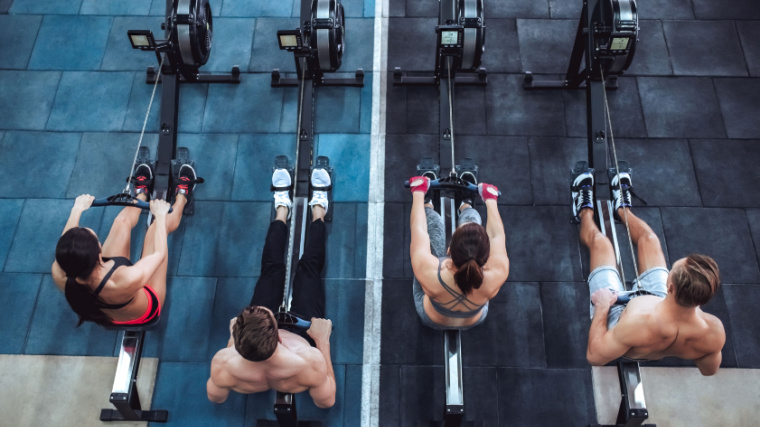
But what if you also have other goals in mind? Sure, you want to skyrocket your cardiovascular fitness, but maybe you’re also looking to get yolked. So the question is: does rowing build muscle? Or will it eat into your hypertrophy goals? Here, you’ll learn everything you need to know about training for gains on the rower.
What Is Rowing?
Yes, you can literally row a boat on the water — but if that water life isn’t for you, you’re likely thinking of an indoor experience of rowing machine workouts when you’re planning out your low-impact cardio.
Rowing machines recreate the fluid movement of rowing on the water — even when they operate with magnets —and can be done anywhere there’s space for the machine: in the gym, your living room, your garage, or even outside.
You’ll push with your legs and pull with your arms to engage your entire body when you’re rowing. You can do low-intensity steady-state cardio (LISS cardio) with long, low-intensity bouts of rowing. Or, you can kick it up a notch and go hard and fast for a high-intensity interval training (HIIT) workout. The imaginary sea is your oyster when you strap into a rower.
Does Rowing Build Muscle?
While people often think of rowing as a cardio-only workout, research may make you reconsider. There’s plenty of evidence to suggest that rowing is an awesome full-body workout for muscle building and cardio, that can give you the muscle mass you’re looking for while building strength in your heart and lungs at the same time.
Not only can rowing build muscle, but it makes use of almost all of your major muscle groups. (1) From your abdominal muscles and back muscles to your quadriceps and shoulder muscles, rowing will give you a full-body experience.
How Muscle Building Works
Muscle growth — known as hypertrophy — requires you to strategically damage your muscles before they can grow. When your body fuses these damaged muscle fibers back together, your muscle mass and size can increase. Eventually, this greater muscle mass can also contribute to greater strength potential. (2)
You need to challenge your body to cause microdamage to your muscles and stimulate growth. Progressive overload — gradually pushing your body harder over time — is a key principle of muscle growth. (2)
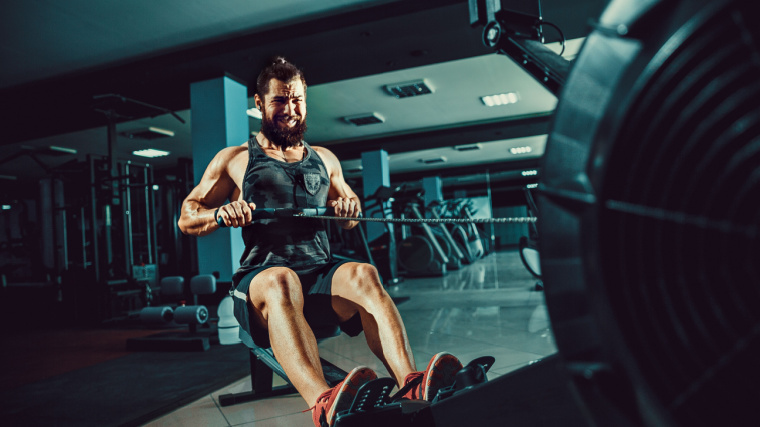
[Read More: The Best Quad Workouts]
That’s because your body adapts to what you put it through. If you get too used to one type of exercise, your gains — both in terms of increased strength and building muscle — will plateau. Using the principles of progressive overload will keep presenting your muscles with new challenges to keep stimulating muscle growth.
What’s the Best Way to Build Muscle?
The long and short of it is that if you want to build muscle, you have to progressively overload your muscles and fuel your body well. That means resistance training — depending on your experience level and intensity, free weights or calisthenics training will do the trick.
Start slowly to meet yourself where you’re at, but gradually increase the intensity of your training to stimulate muscle growth. This might mean lifting heavier weights, increasing your training volume, and using other strategies (like 1 ½ reps and tempo training) to push your muscles closer to failure.
But it’s not just lifting. There are lots of other factors at play here, too, including protein intake, vitamin levels, and hormone levels. (3) Outside of the gym, there are generally two main factors on strength athletes’ minds: diet and sleep.
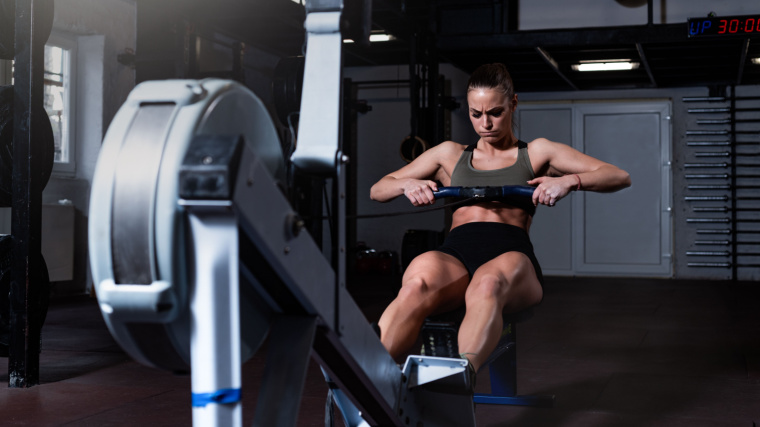
[Read More: The Best Leg Workouts]
Your nutritional plan plays a huge role in your ability to grow muscle. If you’re aiming to build muscle, consider making your daily protein intake roughly 1.6 grams per kilogram of your own body weight. (4)
While training hard is important, recovery days and sleep play an equal role. Research shows that better sleep quality is linked to greater muscle strength in both men and women. The study did not include non-binary people and didn’t mention whether any participants were transgender. (5)
How Much Muscle Can Rowing Build?
The short answer: The more experienced you are, the less likely you are to build a ton of muscle through rowing.
If you’re a newbie to training in general, a rowing machine may well help you build a fair amount of muscle. You’re pushing, you’re pulling, and — most critically — you’re exposing your muscles to new forms of strain. You’re essentially engaging in progressive overload.
But if you’re already an experienced lifter with a bunch of resistance training under your weightlifting belt, rowing will likely be much more of a challenge to your cardiovascular system than a muscle-builder. That’s because you’re already giving your muscles more of an overloaded stimulus with dumbbells and barbells than they get with the rowing machine.
That said, high-intensity rowing may be able to elicit some muscle growth, even in experienced lifters — especially if you’re keeping up with the other aspects of your training. Here’s how that works:
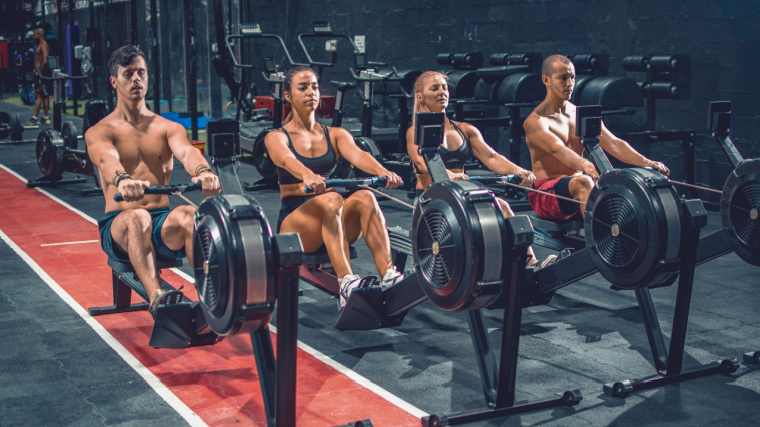
[Read More: The Best EMOM Workouts]
Steady-state endurance rowing is best for recruiting slow-twitch muscle fibers. These are known for having a slow speed of contraction, but a greater level of endurance. They’re less likely to increase muscle size than fast twitch fibers, but they contribute a little. (1)
Short bursts of explosive rowing can activate fast-twitch muscle fibers, the same fibers that are used during heavy weights to bulk up. In a similar manner to running sprints compared to low-intensity running, rowing sprints may have the potential to build more muscle than lower-intensity rowing. (6)
Overall, you’re most likely to gain muscle mass through resistance training: but cranking up the resistance and intensity of your rowing — or simply being a newcomer to the gym — may help the rower help you.
Should Rowers Strength Train?
If you’re aiming to build a significant amount of muscle, the answer here is a resounding yes.
Rowing helps strength training, and strength training helps rowing. If your main goal is building muscle mass, strength training is a must for maximizing your gains. If your main goal is boosting performance on the rower (or on the water), weight training can help you build power for more explosive rowing, as well as more endurance for longer rows. (7)
The Benefits of Rowing
You pretty much can’t go wrong with a rower. While the form may take some getting used to, it usually becomes intuitive rather quickly. The low-to-no-impact nature of the machine renders this one of the best cardio machines for athletes aiming to take it easy on their joints.
It’s Great for all Fitness Levels
Gym newbie? The rower’s a great place to start. While there are plenty of tips and tricks to level up your performance, the basics of a rowing machine are fairly self-explanatory. It’s also low impact, meaning that it could be a great alternative to running for going lighter on your joints.
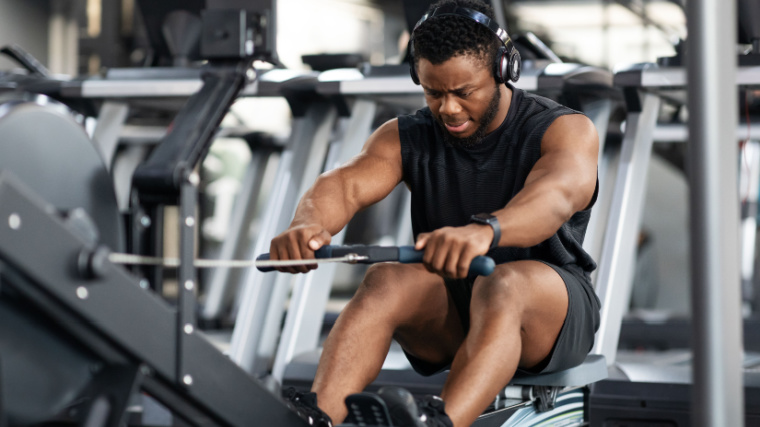
[Read More: The Best Leg Extension Machines]
However, the rowing machine has its place among the training regimes of world-class sport strength athletes, as well. Though it may seem humble, a good workout on the rower has been known to bring many elite athletes to their knees. Just check out the CrossFit Games for all the evidence you need on that front.
It’s a Full-Body Workout
The vast majority of your muscles are used during each rowing stroke, as it requires coordination of full-body push and pull movements. (1) This means you’re getting an upper-body and lower-body workout at the same time.
[Read More: The Best Lower Body Exercises]
Rowing is also a fantastic form of aerobic exercise. Yes, you’ll be working your upper back, quads, and muscles all across your body. But you’ll also be hitting different fitness goals all at once by bringing all your leg muscles, core muscles, and upper body muscles — not to mention your heart and lungs — into the picture.
It Makes a Great Home Workout
If you’re able to secure yourself an indoor rowing machine, you can get a high-intensity workout in the comfort of your own home. The machines don’t take up all that much space, and many can fold or stand up to take up even less room.
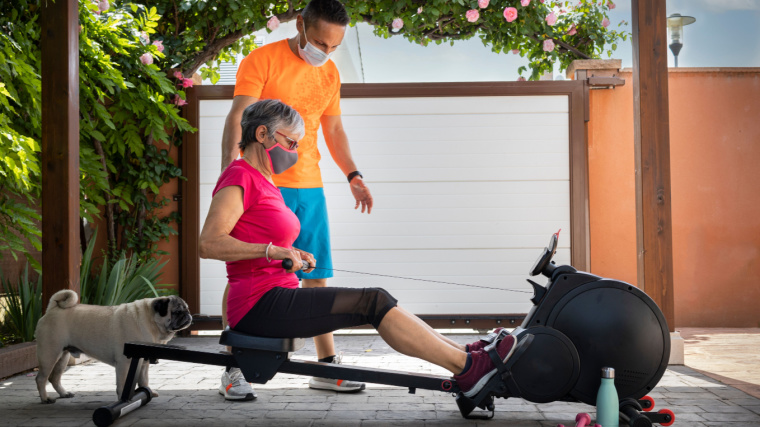
[Read More: The Best Budget Rowing Machines]
Put some gym flooring underneath to muffle any potential sounds, supplement your training with a kettlebell or other easy-to-store piece of home gym equipment, and get to work — without the commute.
[Read More: At-Home Workouts for Strength]
It Boosts Power and Endurance
Short, sharp, high-intensity rowing is great for building power and strength while activating those fast-twitch muscle fibers. Your gains from rowing can carry over to strength training and other sports since you’ll be training yourself to produce force rapidly and in a well-coordinated, full-body effort.
Longer, lower-intensity rows can also boost your lifting performance by increasing your endurance. By keeping your heart rate higher and your muscles pumping over a longer period, you’ll be raising the bar on your work capacity. That’s key for fueling your reps beyond heavy triples or sets of five.
How to Row With Good Form
Mastering your rowing technique will optimize all the benefits of rowing and help with managing your injury risk. There are two phases of the rowing stroke to master — the drive phase and the recovery phase.
The drive phase begins by pushing through your legs, all the way until they’re fully extended. When you reach this point, with your back upright, you can start to pull the handle toward your body. The handle should touch mid-way up your torso, with your elbows and wrists in line with it.

[Read More: The Best Upper Body Exercises and Workouts]
The recovery phase is the opposite of the drive. From the back-upright, legs-straight position, lean your body forward before bending your knees. Your knees bend all the way until your shins are vertical, setting you up for the next drive phase. This phase should be controlled to allow recovery from the drive.
Your Takeaways
Although traditionally known as an aerobic workout to build cardio fitness, rowing can certainly play a role in some muscle growth. While it’s not going to be your major muscle-building driver (unless you’re new to the lifting game), here are some things to keep in mind:
- There are multiple aspects of muscle growth, including the style of training you do. Using the principles of progressive overload with resistance training is key to stimulating hypertrophy.
- The amount of muscle you can build from rowing depends on how you row. While rowing is not going to build muscle like resistance training, newbies and even experienced athletes rowing with very high intensity may be able to develop some muscle mass on the rowing machine.
- Strength training complements rowing and vice versa. For a well-rounded training program that sets up a positive feedback loop between aerobic fitness, work capacity, strength, and muscle growth, it’s a good idea to include both.
- There are a huge number of a rowing machine benefits, including its versatility for different fitness levels, its ability to work your whole body, the ease of use of a rower at home, and the increase in power and endurance you can gain.
Get Rowing
So, does rowing build muscle? For experienced strength athletes, generally not — it’ll be your resistance training that does that. But if you’re new to lifting and the rower is your first dive into the fitness realm, then yes, you may well build some base-level muscles — especially since the rowing machine is incredible for giving you a full-body bodybuilding workout to all your major muscle groups.
In the long run (or…row), rowing machines can contribute to muscle growth by increasing your work capacity and endurance. In turn, this enhanced ability to push harder for longer during workouts can help you lift weights more intensely on the platform. In turn, that can yield more muscle growth. So hit the weights and the rower if you want to really bulk up.
FAQs
Especially if you’re considering investing in a rowing machine, you’ve likely got more questions. Let’s dive in.
Kind of. The amount of muscle you can gain is dependent on your experience level and whether you’re mainly using fast-twitch fibers (think short, explosive movements) or slow-twitch (think cardio endurance workouts).
If you’re a newcomer to training, this growth may be fairly pronounced. But if you’re a more experienced lifter, any muscle gain from rowing may well be negligible. Be sure to supplement your rowing workouts with a resistance training program emphasizing progressive overload to facilitate maximum muscle gain.
Muscle definition is the combination of well-developed muscles with a relatively low body fat percentage. Rowing — especially combined with resistance training — can certainly help create a more “defined” look if you’re using it to help spur body recomposition.
While rowing can be a great way to build muscle, strength training is the best way to rapidly boost muscle mass. To get started, choose compound exercises like back squats, deadlifts, and pull-ups that work lots of muscles at the same time.
Rowing works your quads, hamstrings, calves, glutes, biceps, rhomboids, traps, deltoids, lats, abs, and obliques.
Rowing is an excellent option for beginners and advanced athletes alike, and it’s a time-efficient full-body workout for strength enthusiasts at any level. A rower makes a great addition to your home gym, and you stand to gain strength, power, and cardio fitness for your efforts.
References
- Volianitis, S., Yoshiga, C.C. and Secher, N.H. (2020). The physiology of rowing with perspective on training and health. European Journal of Applied Physiology, 120(9), pp.1943–1963.
- Plotkin, D., Coleman, M., Van Every, D., Maldonado, J., Oberlin, D., Israetel, M., Feather, J., Alto, A., Vigotsky, A.D. and Schoenfeld, B.J. (2022). Progressive overload without progressing load? The effects of load or repetition progression on muscular adaptations. PeerJ, [online] 10, p.e14142.
- Westcott, W.L. (2012). Resistance training is medicine: Effects of strength training on health. Current Sports Medicine Reports, 11(4), pp.209–216.
- Stokes, T., Hector, A., Morton, R., McGlory, C. and Phillips, S. (2018). Recent Perspectives Regarding the Role of Dietary Protein for the Promotion of Muscle Hypertrophy with Resistance Exercise Training. Nutrients, [online] 10(2), p.180.
- Chen, Y., Cui, Y., Chen, S. and Wu, Z. (2017). Relationship between sleep and muscle strength among Chinese university students: a cross-sectional study. Journal of musculoskeletal & neuronal interactions, [online] 17(4), pp.327–333.
- Estes RR, Malinowski A, Piacentini M, Thrush D, Salley E, Losey C, Hayes E. The Effect of High Intensity Interval Run Training on Cross-sectional Area of the Vastus Lateralis in Untrained College Students. Int J Exerc Sci. 2017 Jan 1;10(1):137-145.
- Thiele, D., Prieske, O., Chaabene, H. and Granacher, U. (2020). Effects of strength training on physical fitness and sport-specific performance in recreational, sub-elite, and elite rowers: A systematic review with meta-analysis. Journal of Sports Sciences, 38(10), pp.1186–1195.
Featured Image: 4 PM production / Shutterstock